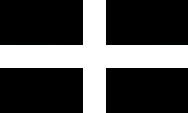Cornwall |
|
|
|
| Übersicht – Contents: | |
Cornwall |
|
|
|
| Übersicht – Contents: | |
Flaggen – Flags: |
|
 |
Flagge von Cornwall – flag of Cornwall, Seitenverhältnis – ratio = 3:5, Quelle/Source: Die Welt der Flaggen   |
 |
Flagge des Herzogs von Cornwall – flag of the Duke of Cornwall, Seitenverhältnis – ratio = 3:5, Quelle/Source: Flags of all Nations   |
| Die Flagge von Cornwall zeigt das Kreuz von St. Piran, dem Schutzheiligen der Zinnbergarbeiter. Das Schwarz steht für das Erz, das Weiß für das erschmolzene Metall. Letzlich sind es aber die keltischen Nationalfarben Schwarz und Weiß, angeordnet in der Form des englischen Georgskreuzes. | The flag
of Cornwall shows the cross of St. Piran, the patron saint of the pewter
workers. The black stands for the ore, the white for the molten metal.
However, they are the Celtic national colors black and white, arranged in the form of the English Saint George's cross. |
| Quelle/Source: Die Welt der Flaggen | |
| Wappen – Coat of arms: | |
 |
Wappen von Cornwall – coat of arms of Cornwall, Quelle/Source, nach/by: Wikipedia (EN), Sodacan, CC BY-SA 3.0, via Wikimedia Commons |
| Cornwall ist heute nicht nur eine historische Grafschaft und zeremonielle Grafschaft, sondern auch ein titulares Herzogtum. Der Titel wird traditionell vom Prince of Wales geführt. Das Wappen von Cornwall wurde im 15. Jahrhundert entworfen und geht auf Richard, Earl of Cornwall (1209-1272) zurück. Aus seinem Wappen wurden die goldenen Besanten (= Byzantinische Goldmünzen) entnommen und in einer 15-er-Kombination neu angeordnet und zunächst für die "Ancient and Honourable Association of Pawnbrokers" übernommen. Das Arrangement sollte die Gleichheit der fünf Mitglieder der Association symbolisieren. | Cornwall today is not only a historic county and ceremonial county, but also a titular duchy. The title is traditionally held by the Prince of Wales. The coat of arms of Cornwall was designed in the 15th century and dates back to Richard, Earl of Cornwall (1209-1272).
The golden bezants (= Byzantine gold coins) were removed from his coat of arms and rearranged in a combination of 15, and were initially adopted for the "Ancient and Honorable Association of Pawnbrokers". The arrangement was intended to symbolize the equality of the five members of the association. |
| Quelle/Source: Wikipedia (EN) | |
Landkarte – Map: |
 Quelle/Source: Freeware, University of Texas Libraries, modyfied by: Volker Preuß |
|
|
| Zahlen und Fakten – Numbers and Facts: | |
|
|
|
|
|
|
|
|
|
|
|
|
|
|
ca. 600 v.Chr. · keltische Besiedlung 57 v.Chr.–74 n.Chr. · zum Römischen Reich, Provinz Britannia ab ca. 400 · Abzug der römischen Legionen, in den Folgejahren Einwanderung der germanischen Stämme der Angeln, Sachsen und Jüten, die später unter dem Begriff Angelsachsen zusammengefasst wurden, Cornwall wird Rückzugsgebiet für die keltischen Briten ca. 950 · Unterwerfung durch die Sachsen, Cornwall kommt an das Königreich England |
|
ca. 600 B.C.
· Celtic settlement 57 B.C.–74 A.D. · to the Roman Empire, province of Britannia from ca. 400 · withdrawal of the Roman legions, in the following years immigration of the Germanic tribes of the Angles, Saxons and Jutes, which were later summarized under the term Anglo-Saxons, Cornwall becomes a retreat for the celtic British ca. 950 · subjugation by the Saxons, Cornwall comes into the Kingdom of England |
| Quelle/Source: Atlas zur Geschichte, Discovery '97, Wikipedia (DE) |
| Der Name "Cornwall" besteht aus zwei Bestandteilen: Das Wort "corn" geht auf den früher hier lebenden keltischen Stamm der Cornovii ab. "Weahlas" meint "welsch", was eigentlich "fremd" heißt. So nannten die Germanen romanisierte Germanen oder Kelten. | The name "Cornwall" consists of two parts: The word "corn" refers to the former Celtic tribe of Cornovii, who former lived here.
"Weahlas" means "welch", which means "foreign". Thus the Germanics called Romanized Germanics or Celts. |
| Quelle/Source: Wikipedia (DE) | |